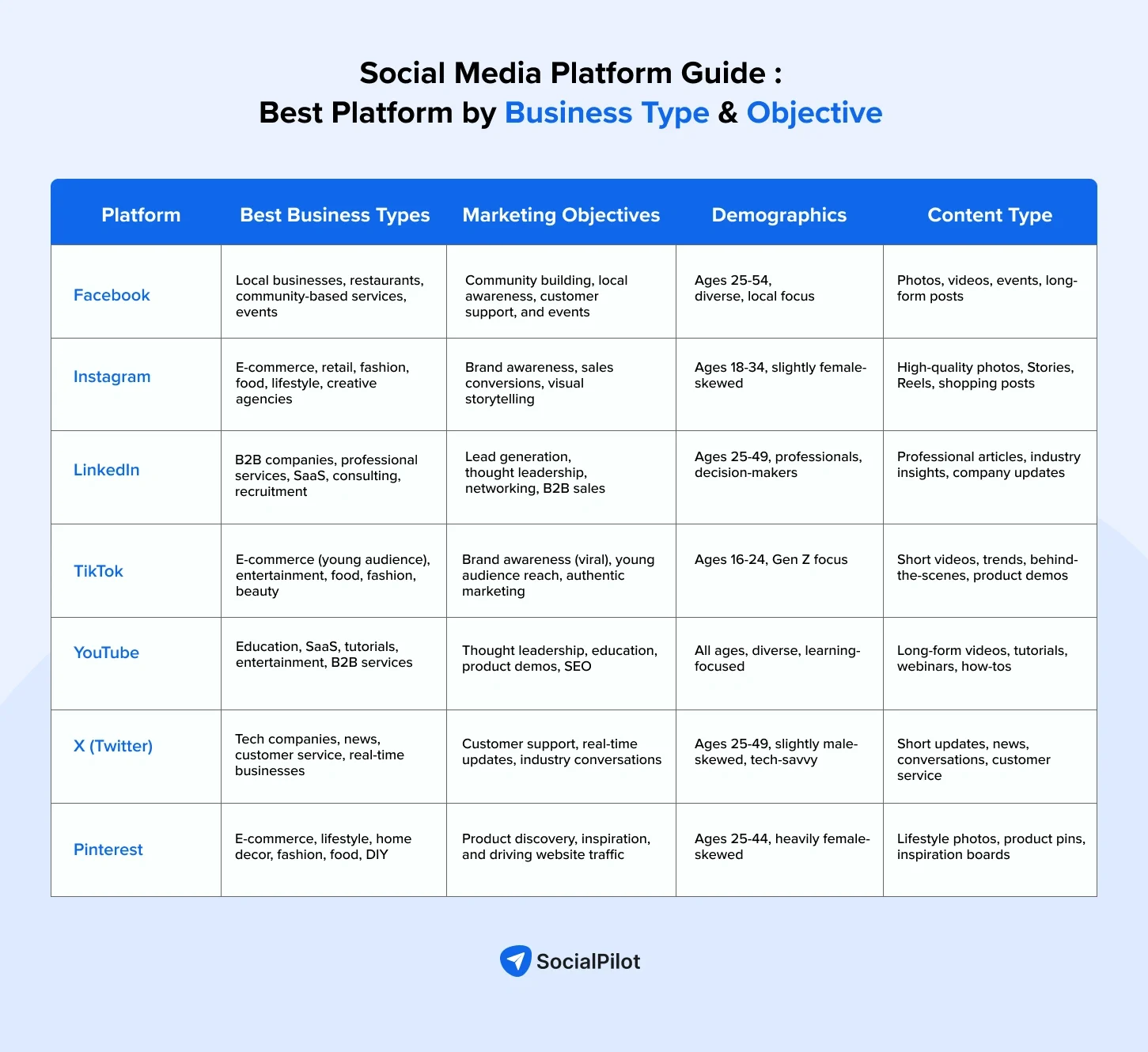You’re not alone if you’re working on your social media presence, but not seeing much traction. Many businesses, from local shops to global brands, are active on social platforms yet struggle to see a meaningful return on their investment. You’re posting, you’re engaging, but the results just aren’t there.
The good news? You don’t need to scrap everything and start over. The key isn’t always putting in more effort, but a more focused strategy tailored to your specific business goals, audience, and the unique dynamics of each platform.
In this guide, we’ll go beyond the basics, breaking down proven strategies, effective tools, and best practices designed to help you amplify your current social media presence and finally achieve the tangible results you’ve been working towards.
Social media isn’t just a marketing channel anymore; it’s a dynamic ecosystem designed to address the very real, often frustrating challenges businesses face today. If you’re already active but not seeing the payoff, it’s time to shift your perspective.
Social platforms are powerful tools that, when wielded strategically, can help you not only attract new customers and drive traffic but also understand true customer sentiment, expand market reach, cultivate deep loyalty, and gain crucial competitive insights in real-time.
Here’s how:
1. Problem 1: “We’re struggling to stand out in a noisy, competitive market.”
It’s an undeniable truth that the digital landscape is saturated. Every brand, big or small, is looking for attention, and your customers are constantly bombarded with options. This isn’t just about local competition anymore; you’re up against businesses globally. The real pain point? You’re investing time and effort into your social media, but your messages often disappear into the noise, making your brand feel invisible
Solution: Social media builds visibility and voice.
Social media platforms give you a personality. You don’t need a million-dollar budget to get noticed. You need consistent, clear messaging that reflects who you are and why you matter.
Instead of just posting, focus on strategic tactics:
- Share compelling narratives: Use Instagram Stories for authentic behind-the-scenes glimpses that reveal your team and values.
- Demonstrate thought leadership: Craft insightful LinkedIn posts that offer genuine value and perspective on industry trends.
- Embrace relatable trends: Leverage platforms like TikTok for short, engaging content that’s relevant and memorable, showcasing your brand’s human side.
By consistently showing up with authentic, valuable, and strategically designed content, you build recognition and trust. This will allow your brand to truly stand out amidst the competition.
2. Problem 2: “Customers remain skeptical of businesses.”
Modern customers are sharper, better informed, and more skeptical than before. They’ve grown wary from a constant flow of polished marketing, inconsistent brand messages, and even past negative experiences with online businesses.
Even when your business operates with integrity and transparency, cutting through this skepticism is a significant concern. You’re trying to build genuine connections, but your audience is inherently cautious, questioning authenticity and intent. This makes earning and maintaining customer trust exceptionally challenging, often despite your best efforts to be real.
Solution: Build Credibility and Authenticity Through Consistent, Responsive Engagement.
One effective way to build credibility is by sharing behind-the-scenes moments, real customer experiences, and content that reveals the human side of your brand. This helps people connect with who you are, not just what you offer.
But authenticity goes beyond just what you share. It also comes through in how you engage. Responding promptly and with empathy to comments and messages shows that you truly care about your audience. In addition, showcasing user-generated content and testimonials adds another layer of trust, letting your customers speak on your behalf. This kind of social proof is one of the most effective ways to build lasting credibility.
When you are transparent about your values and consistently show up with honesty and empathy, people are much more likely to believe in your brand and stay loyal to it.
3. Problem 3: “We don’t really know what our customers want anymore.”
Customer behavior is changing fast. What worked last year (or even last month) might be falling flat now. Your customers want everything personalized, they expect lightning-fast responses, and they’re hunting for more value than ever before.
All this constant change leaves most business owners feeling totally out of touch with their audience. And here’s the kicker. 82.4% of businesses admit they don’t confidently know what’s bothering their customers. This makes strategic decision-making expensive guesswork.
Solution: Social media gives you a live feedback loop.
The beauty of social media? This is a space where people tell you what they like and don’t every day. Through likes, shares, comments, and messages, your audience gives you real-time insights. You can test new ideas, see what content hits, and adjust your approach on the fly.
You don’t always need surveys to understand your customers. Often, the insights are already built into the platform. Through their comments, reviews, and messages, your customers are already telling you what matters most to them.
4. Problem 4: “Traditional marketing is too expensive — and kind of hit-or-miss.”
Traditional marketing remains relevant for many businesses targeting older or less digitally engaged demographics. Through TV advertisements, print media, billboards, and more, you may have already been reaching out to your audience in mass.
Although traditional marketing methods are still very useful today, they do not come without significant upfront costs and limited ways to measure exact returns. It’s challenging to determine precisely who saw your message or whether it actually resulted in a sale. This lack of detailed insight and the substantial financial outlay make scaling effective marketing efforts a costly gamble, especially when every budget dollar counts.
Solution: Social media is marketing you can actually afford — and measure.
Social media doesn’t aim to replace traditional marketing, but it brilliantly bridges its gaps. Instead of broad, expensive campaigns, social platforms allow you to pinpoint your ideal audience with remarkable accuracy, ensuring your marketing spend reaches those most likely to convert.
Moreover, every click, like, and share is trackable, providing you with real-time data on campaign performance. This unparalleled measurability means you can optimize on the fly, investing more in what works and refining what doesn’t, turning marketing from a hit-or-miss expense into a data-driven investment.
5. Problem 5: “Our customers aren’t sticking around — loyalty is slipping.”
People have more choices than ever. They might buy from you once and then never come back. Loyalty is fragile, and it’s easy for your brand to get lost in the scroll. If you’re not staying in front of your audience, someone else is.
Solution: Social media keeps the connection alive.
Think of your social media channels as a post-sale tool. It’s where you stay in your customer’s world after the purchase. Share useful tips, celebrate customer stories, respond to comments, and more. All these little things will make the people feel seen.
Over time, this can help you build relationships that help you drive loyalty. When customers feel connected, they’re far more likely to return and bring more potential customers.
6. Problem 6: “Our digital transformation is dragging — we can’t keep up.”
Everyone’s talking about going “digital-first,” but executing it is a different story. New tech is expensive, platforms are confusing, and the learning curve is real. Many businesses are stuck in limbo, unsure of where to start or how to move forward.
Solution: Social media is your fastest digital win.
You don’t need to revamp your entire infrastructure to start seeing results. Setting up or optimizing your social media presence is one of the quickest, most effective digital moves you can make. You can start small — posting consistently, engaging with your audience — and build momentum. Plus, there are tons of tools to help you automate, schedule, and analyze without needing a tech team.
Let’s be honest, posting random content and hoping it “goes viral” isn’t a strategy.
Social media success doesn’t come from luck. It comes from having a clear, focused plan that aligns with your business goals, your audience’s needs, and the platforms where they spend time. And the best part? You don’t need a full-time team or a huge budget to make it work. You just need an innovative approach and some consistency.
Another great news is that you don’t have to reinvent the wheel. There are tried-and-true social media strategies for businesses that successful brands use every day to stay consistent, build community, and drive results.
Below, you’ll find some of the best strategies curated by our social media experts. These
10+ must-have strategies will immediately level up your presence and results.
1. Define Your Business Goals
Before anything else, get clear on why you’re using social media. Is it to boost brand awareness? Drive traffic? Generate leads? Your content, platform choices, and posting style should all align with those goals. Start with the big picture, then break it down into measurable KPIs so you can track progress and adjust as needed.
2. Understand Your Target Audience
You can’t connect with people if you don’t know who they are. Think about your ideal customer: What are their interests? What problems are they trying to solve? Where do they spend time online? The better you understand your audience, the easier it is to create content that speaks their language and shows up where they’re already scrolling.
3. Analyze Your Competitors
Don’t reinvent the wheel, rather learn from it. Take a look at what your competitors are doing on social media. What content performs well? Where do they get engagement? What gaps can you fill? Competitor research helps you identify what works (and what doesn’t), so you can craft a smarter, more strategic approach that sets you apart.
Your voice is your vibe. Whether you’re playful, professional, bold, or heartfelt, your tone should reflect your brand’s personality. Make sure it’s consistent across platforms so people recognize you instantly. Think of it like how your brand would talk in real life — then keep that tone across your captions, replies, and stories.
First impressions count — and your profile is your digital storefront. Use high-quality profile images, write clear and keyword-rich bios, and include links that drive traffic to your site or key offers. Small tweaks like pinning important posts or using branded highlights can make a big difference in how people view and trust your brand.
6. Develop a Compelling Content Plan
Random posting won’t get you far. Create a content plan that aligns with your goals and audience. Mix up content types: educational, behind-the-scenes, user-generated content, and promotions. A content calendar helps you stay consistent and avoid scrambling at the last minute. Think quality over quantity — make every post count.
Posting without tracking is like driving blindfolded. Use analytics to understand what’s working and what isn’t. Look at metrics like reach, engagement, clicks, and conversions. Then tweak your strategy accordingly. Over time, data helps you post smarter, spend better, and turn social media into a performance machine.
8. Build a Strong Community Around Your Brand
Don’t just post content. Social media is about building relationships, not just broadcasting. Reply to comments, ask questions, reshare customer content, and show appreciation. Over time, this builds a loyal community that trusts you, supports you, and promotes you and sometimes even more effectively than your own marketing team.
9. Leverage Paid Advertising for a Boost
If your organic reach is not where it used to be, you can try paid advertising to boost your outreach. However, that doesn’t mean you need a huge ad budget. A small, well-targeted spend on platforms like Meta, TikTok, or LinkedIn can help amplify your best content and reach the right people. Start small, test often, and focus on clear goals like website clicks or lead gen.
Managing multiple platforms is tough without the right tools. Use schedulers like Buffer, SocialPilot, or Hootsuite to plan posts, track analytics, and stay organized. It’ll save you time, help you stay consistent, and give you a better big-picture view of your entire strategy.
Not every platform is made for your brand, and that’s okay. The key is choosing the one social media platform that aligns with your goals and where your audience spends time. If your content is highly visual, Instagram or Pinterest might be your sweet spot.
For B2B or professional services, LinkedIn often delivers better results. Don’t just follow trends, follow relevance. It’s better to go deep on fewer platforms than to stretch thin across five. Focus your energy where you can be consistent, valuable, and actually build a presence that sticks.

Zappos is an online retailer that sells shoes, clothing, and other accessories. It is well-known for its focus on customer service. However, its social media strategy offers a more profound lesson for businesses struggling to build trust and connection.
Long before direct messaging became standard, Zappos actively used platforms like Twitter not just to solve problems, but to delight and proactively engage, turning routine interactions into powerful brand differentiators.
The Challenge
In a competitive online retail space, where products are often similar, Zappos needed to build more than just simple business transactions. They needed to foster deep customer loyalty and trust, proving their commitment to the customer experience beyond the shopping cart.
What They Did
Zappos extended its renowned customer service philosophy directly onto social platforms. While they responded to inquiries, their true innovation was in their proactive engagement. Their social media teams didn’t wait for complaints; they actively monitored conversations, engaging with customers who simply mentioned shoes or shopping, even if it wasn’t a direct query about Zappos.
They’d offer unsolicited advice, share relevant content, or even send unexpected small gifts, transforming followers into brand advocates. This wasn’t just “being human”; it was a systematic strategy of empathetic, spontaneous connection.
The Magic Moment
Instead of limiting customer service to phone calls or emails, Zappos treated every public social mention as an opportunity for connection. Whether it was helping someone find a specific shoe style or publicly celebrating a customer’s purchase, these consistent, genuine interactions built rapport and trust in the online retail space. This created a powerful narrative that amplified their core brand value: customer obsession.
Results
Zappos became synonymous with exceptional customer experience, significantly differentiating itself in a crowded market. Their social media engagement directly contributed to their industry-leading customer retention rates and word-of-mouth referrals.
The intangible benefit was a fiercely loyal customer base who felt genuinely valued, proving that authentic, proactive social engagement builds far deeper connections than typical marketing messages.
Key Takeaway
For businesses struggling to earn trust, social media isn’t just a place to respond. It’s an arena for proactive customer delight. By consistently listening, engaging spontaneously, and offering genuine value, you can transform skeptical followers into loyal advocates, demonstrating your brand’s true commitment and building credibility one meaningful interaction at a time.
Success Story 2: ASOS – Empowering Customers to Drive Sales and Style Inspiration
ASOS, a UK-based online fashion and cosmetics retailer, primarily targets young adults with a wide range of clothing, shoes, accessories, and beauty products from both its own labels and popular global brands.
One of its key challenges was making its extensive product catalog feel personal, relevant, and inspiring to its diverse, style-savvy audience, ultimately turning inspiration into conversions.
The Challenge
As a pure-play online retailer with thousands of products, ASOS needed to bridge the gap between high-fashion imagery and how real customers would wear their clothes. They aimed to create a more authentic, community-driven shopping experience on social media that directly influenced purchase decisions, rather than just showcasing products.
What They Did
ASOS launched the highly successful #AsSeenOnMe campaign, a pioneering initiative that encouraged customers worldwide to post photos of themselves wearing ASOS clothing on Instagram and other platforms, using the designated hashtag.
Crucially, ASOS didn’t just passively collect these images; they actively curated and reposted the best user-generated content (UGC) on their official social channels and even integrated it directly onto product pages on their website. This transformed customers into stylists and models, providing authentic social proof.
The Magic Moment
The campaign tapped into the desire of fashion enthusiasts to share their style and see how clothes looked on “real” people. When a customer saw someone with a similar body type or personal style rocking an ASOS outfit, it provided powerful, relatable inspiration that a professional model photo couldn’t.
This peer-to-peer validation significantly boosted confidence in purchases and made shopping feel more like joining a community.
Results
#AsSeenOnMe dramatically increased customer engagement, transforming ASOS’s social channels into dynamic style guides driven by its own community. The campaign generated millions of user-submitted photos, creating an enormous library of authentic content that served as powerful social proof.
This direct integration of UGC into the shopping journey not only enhanced brand loyalty but also demonstrably drove sales by making products more accessible, relatable, and desirable to potential buyers.
Key Takeaway
For businesses struggling to convert social media engagement into sales, the ASOS #AsSeenOnMe case study highlights the immense power of strategic user-generated content (UGC).
By empowering your customers to create and share content related to your products or services, you can build authentic social proof that resonates far more deeply than traditional marketing, directly influencing purchasing decisions and fostering a vibrant, sales-driving community.
Common Mistakes Businesses Make (and How to Avoid Them)
Even with the best intentions, a lot of businesses fall into the same social media traps — and end up wondering why their content isn’t delivering. The good news? Most of these mistakes are easy to fix once you spot them. Let’s break down some of the most common missteps and how to steer clear of them.
1. Inconsistent Posting
The Problem
Posting in bursts, then ghosting for weeks, sends mixed signals to your audience. It makes your brand look unreliable and forgettable. People may even assume your business isn’t active anymore. Worse, social media algorithms don’t reward inconsistency, so your reach plummets over time.
The Fix
Pick a posting rhythm you can realistically stick to. It’s better to post 3 times a week consistently than 10 times in one week and nothing the next. Use a simple content calendar and schedule posts ahead with tools like SocialPilot, Buffer or Later. Consistency creates trust, and trust builds engagement.
2. Not Replying to Comments or Messages
The Problem
Social media is a two-way street. If you’re posting but not engaging, you’re missing half the equation. When people take the time to comment, ask a question, or send a message and hear nothing back, they feel ignored. That can cost you not only sales but long-term loyalty.
The Fix
Treat engagement like customer service. Responding promptly (even if it’s just a like, emoji, or “Thanks!”) shows your brand is present and approachable. Set aside time daily to check your notifications. If you’re a larger business, assign team roles or use social inbox tools to stay on top of it.
3. Ignoring Data and Metrics
The Problem
Posting blindly without reviewing analytics is like throwing darts with your eyes closed. You might get lucky, but you won’t know why something worked or didn’t. Many brands continue to push content without realizing it’s not resonating, simply because they’re not tracking its performance.
The Fix
Regularly check platform insights to see what’s actually working. Are Reels driving more engagement than static posts? Are people clicking your links or just liking your memes? Focus on key KPIs, such as engagement rate, reach, clicks, and conversions. Then, double down on what works and refine what doesn’t. Let data guide you.
4. Using the Same Strategy Across All Platforms
The Problem
Every platform has a different vibe, user base, and content expectation. What works on TikTok might bomb on LinkedIn. Copying and pasting the same content across all platforms not only underperforms, it can make your brand look tone-deaf.
The Fix
Tailor your approach. Use LinkedIn for thought leadership and professional insights. Utilize Instagram for visuals, stories, and behind-the-scenes content. Use Twitter or X for real-time engagement or quick updates. You don’t need to reinvent every post, just adapt the message and format to fit the platform. Your audience will feel the difference.
5. Lack of Strategy — or Over-Reliance on Trends
The Problem
Chasing every trending sound or viral meme without a clear strategy is like shouting into the void. You might get a few likes, but you won’t build long-term brand value. Many brands get caught up in staying “relevant” and lose sight of their voice and goals.
The Fix
Start with a clear strategy: what’s your goal — awareness, leads, engagement, loyalty? Define your brand voice and content pillars (e.g. education, entertainment, testimonials). Use trends selectively only when they align with your brand tone and audience. Trends can boost visibility, but strategy builds trust and consistency.
Conclusion
Social media isn’t just about posting. It’s about connecting, building, and growing. Whether you’re a small business looking to stand out, an agency managing multiple brands, or an enterprise navigating digital transformation, the right strategy can make all the difference.
Focus on consistency, clarity, and authenticity, and let your brand’s personality shine. Start small, stay intentional, and remember that social media is a long game. However, when done right, it’s one of the most powerful tools your business can have in the years to come.
To make that journey easier, you need a platform that can help you plan, publish, analyze, and engage all from one place. SocialPilot can help you stay consistent and focused on building real connections. Get a free trial today and find out how it simplifies your social media workflow.






